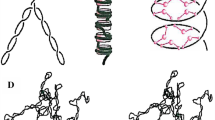Abstract.
Simple considerations of statistical mechanics show that the association of an enzyme with another protein or with an ‘inert’ surface results in a decrease of its information content and thus that it receives an ‘instruction’ from this protein or from the surface. As a consequence, the free energy stored in the enzyme increases, and this energy may be used to alter the intrinsic catalytic properties of the enzyme. This may imply, for instance, that an enzyme which is devoid of activity may have its activity enhanced when bound to another protein or to a membrane. A possible consequence of this communication between proteins is that, upon dissociation of the complex, one of these enzymes may transitorily retain an imprinting of the other protein and this imprinting may in turn alter the properties of the enzyme. Different enzyme systems may illustrate this view. A particular emphasis has been put on the study of a phosphoribulokinase-glyceraldehyde phosphate dehydrogenase complex from Chlamydomonas chloroplasts. Whereas the isolated oxidized phosphoribulokinase is almost completely inactive, it becomes active when bound to glyceraldehyde phosphate dehydrogenase. Moreover, upon dissociation of the complex, the phosphoribulokinase retains for a while an imprinting exerted by glyceraldehyde phosphate dehydrogenase. It then displays properties that are markedly different from those of the free stable enzyme. Thermodynamics allows us to calculate the amount of energy stored in this enzyme and used to facilitate substrate binding and catalysis. There is thus little doubt that information and instructions are transferred from protein to protein within enzyme complexes that result in a complete change of their biological function.
Similar content being viewed by others
Author information
Authors and Affiliations
Additional information
Received 6 January 1998; received after revision 18 June 1998; accepted 24 June 1998
Rights and permissions
About this article
Cite this article
Ricard, J., Gontero, B., Avilan, L. et al. Enzymes and the supramolecular organization of the living cell. Information transfer within supramolecular edifices and imprinting effects. CMLS, Cell. Mol. Life Sci. 54, 1231–1248 (1998). https://doi.org/10.1007/s000180050250
Issue Date:
DOI: https://doi.org/10.1007/s000180050250




